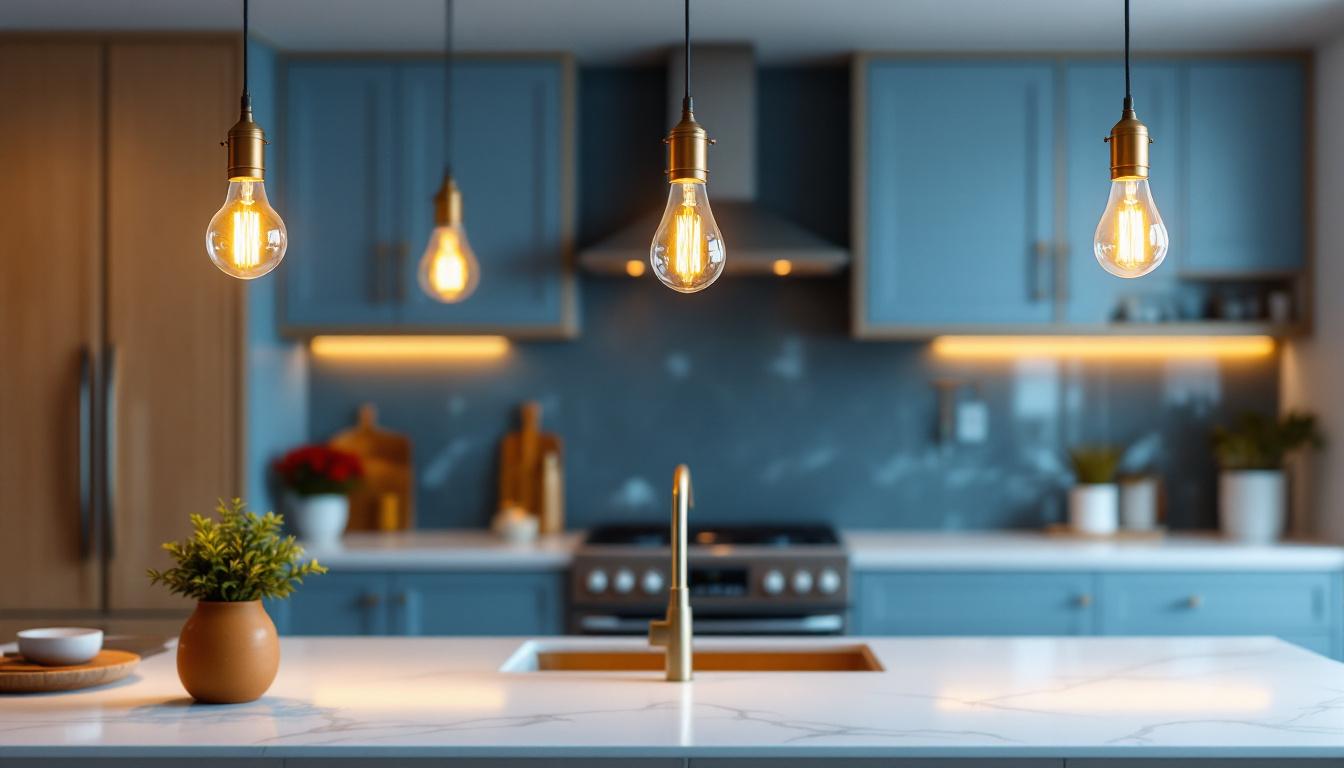
Kitchen islands have become the centerpiece of modern kitchens, serving as hubs for cooking, dining, and socializing. Pendant lights above these islands do more than just illuminate; they set the mood, highlight design elements, and provide task lighting where it’s needed most. For lighting contractors, selecting the right bulb for these fixtures is critical. The wrong choice can lead to poor visibility, unflattering color rendering, or even energy inefficiency.
Unlike general overhead lighting, kitchen island pendants demand a balance between brightness, color temperature, and style. The bulb must complement the fixture’s design while delivering functional illumination that enhances the user experience. This checklist will guide contractors through the essential factors to consider when choosing bulbs for kitchen island pendants.
When considering the aesthetic aspect, the style of the pendant light itself plays a significant role in determining the type of bulb that should be used. For instance, a vintage Edison bulb can beautifully accentuate a rustic or industrial-style pendant, adding a warm glow that enhances the overall ambiance. Conversely, a sleek, modern pendant may benefit from a brighter, cooler LED bulb that emphasizes its clean lines and contemporary design. Additionally, the height at which the pendants are hung can affect the perceived brightness and spread of light, necessitating careful planning to ensure that the illumination is both effective and visually appealing.
Furthermore, energy efficiency is a crucial consideration in today’s eco-conscious market. With advancements in lighting technology, LED bulbs have emerged as a popular choice due to their longevity and lower energy consumption compared to traditional incandescent bulbs. Many homeowners are now opting for smart lighting solutions that allow for dimming and color temperature adjustments, providing versatility for various occasions—from bright, focused lighting during meal prep to softer, warmer tones for entertaining guests. Understanding these trends and preferences can help contractors make informed recommendations that align with their clients’ needs while also promoting sustainable practices in kitchen design.
Brightness is the first consideration. Kitchen islands require sufficient light for food preparation, reading recipes, and other detailed tasks. Lumens measure the actual light output of a bulb, and for kitchen island pendants, a range between 800 to 1,100 lumens per bulb is typically ideal. This equates roughly to a 60 to 75-watt incandescent bulb in terms of brightness but with far greater energy efficiency if using LED alternatives.
Keep in mind the number of pendants and bulbs per fixture. Multiple smaller bulbs can provide more even illumination and reduce shadows, which is crucial in a workspace. Also, consider dimmable bulbs to offer flexibility for different activities and moods.
Color temperature, measured in Kelvin (K), affects the ambiance and functionality of kitchen lighting. For kitchen islands, bulbs in the 2700K to 3000K range produce a warm white light that complements wood tones and warm finishes. For a crisper, more modern look, 3500K to 4000K bulbs offer a neutral white light that enhances visibility without feeling clinical.
Color Rendering Index (CRI) is equally important. CRI measures how accurately a light source reveals colors compared to natural light. A CRI of 80 or above is recommended for kitchen island lighting to ensure food and surfaces appear vibrant and true to life. High CRI bulbs are especially vital in kitchens where color differentiation affects cooking and presentation.
Kitchen island pendants come in various styles, from sleek minimalist designs to ornate vintage fixtures. The bulb’s shape can influence both the fixture’s aesthetics and light distribution. Common shapes include A19 (standard), G25 (globe), and ST19 (tubular or Edison style). Globe bulbs are popular for pendants with clear glass shades, offering a decorative element alongside functionality.
Base compatibility is another practical consideration. Most pendant fixtures use E26 medium bases, but some designs may require candelabra (E12) or other specialty bases. Confirming the base type upfront prevents installation delays and ensures a seamless fit.
Energy efficiency is a priority for contractors advising clients on sustainable and cost-effective lighting solutions. LED bulbs outperform traditional incandescent and halogen bulbs by using up to 85% less energy and lasting 15 to 25 times longer. This translates into lower utility bills and reduced maintenance costs over time.
Look for bulbs with ENERGY STAR certification to guarantee performance standards. Additionally, bulbs with longer rated lifespans (25,000 hours or more) reduce the frequency of replacements, which is especially beneficial in hard-to-reach pendant fixtures.
Dimming adds versatility to kitchen island lighting, allowing users to adjust brightness for cooking, dining, or entertaining. Not all bulbs are dimmable, and even among dimmable LEDs, compatibility with existing dimmer switches varies. Lighting contractors should verify that the selected bulbs support dimming and match the dimmer type-whether leading-edge or trailing-edge-to avoid flickering or buzzing.
Testing bulbs with the client’s dimmer system before final installation can save time and prevent dissatisfaction. Offering dimmable options also adds value to the lighting design, enhancing client satisfaction.
Glare can be a problem with pendant lighting, especially when bulbs are exposed or fixtures have clear glass shades. Bulbs with frosted or coated finishes help diffuse light and soften glare, improving visual comfort. Some LED bulbs incorporate built-in diffusers or use filament designs that mimic the warm glow of incandescent bulbs without harsh brightness.
For fixtures with open bulbs, consider using bulbs with lower candela ratings or adding shades and diffusers to minimize direct glare. This attention to detail elevates the overall lighting quality and user experience.
Smart bulbs offer advanced control features such as color tuning, scheduling, and remote operation via apps or voice assistants. For kitchen islands, this can mean adjusting color temperature throughout the day or setting scenes for different activities. While smart bulbs tend to be pricier, they provide flexibility and convenience that appeal to tech-savvy clients.
Contractors should evaluate the client’s interest in smart home integration and recommend bulbs compatible with popular ecosystems like Zigbee, Z-Wave, or Wi-Fi. Ensuring reliable connectivity and ease of use is key to a successful smart lighting installation.
LEDs dominate the market for kitchen island pendant lighting due to their efficiency, longevity, and versatility. They come in a wide range of color temperatures and CRI ratings, making it easy to tailor lighting to the space. Modern LED filament bulbs combine vintage aesthetics with contemporary performance, ideal for exposed bulb fixtures.
Additionally, LEDs generate less heat, which is beneficial in kitchens where heat buildup can be an issue. Their instant-on capability and compatibility with dimmers further enhance their appeal.
Halogen bulbs offer excellent color rendering and a bright, crisp light that some clients prefer for task lighting. However, they consume more energy and produce more heat than LEDs. Halogens are less common in new installations but may still be specified for certain design aesthetics or retrofit projects.
Contractors should weigh the higher operating costs and shorter lifespan against the lighting quality benefits when considering halogen bulbs.
Traditional incandescent bulbs provide warm, flattering light but are largely phased out due to inefficiency and short lifespan. They are rarely recommended for kitchen island pendants except in vintage or specialty fixtures where authentic incandescent glow is essential.
Given modern alternatives, incandescent bulbs are generally not the best choice for contractors focused on energy savings and durability.
Before installation, verify the fixture’s maximum wattage rating and ensure the selected bulbs do not exceed it. Confirm the electrical supply and switch type to guarantee compatibility with dimmable or smart bulbs. Measuring the height and spacing of pendants will help achieve balanced illumination across the island.
Discuss lighting goals with the client-whether they prioritize ambiance, task lighting, or energy savings-to tailor bulb selection accordingly.
After installation, test all bulbs for proper operation, dimming function, and absence of flicker or buzzing. Check for uniform light distribution and adjust pendant height or alignment if necessary. Educate clients on bulb replacement options and maintenance schedules to prolong fixture performance.
Encourage clients to clean bulbs and fixtures regularly to maintain brightness. Advise on using bulbs from the same batch to ensure consistent color temperature and output. For smart lighting systems, recommend periodic firmware updates and troubleshooting tips to keep controls responsive.
Choosing the best light bulbs for kitchen island pendants involves more than picking the brightest or most affordable option. Lighting contractors must consider brightness, color temperature, CRI, bulb shape, energy efficiency, dimming compatibility, and client preferences to create a lighting scheme that is both functional and stylish.
LED bulbs stand out as the top choice for most kitchen island applications due to their versatility and performance. However, understanding the nuances of each bulb type and fixture design ensures contractors can provide tailored solutions that satisfy even the most discerning clients.
By following this comprehensive checklist, contractors can confidently specify bulbs that enhance kitchen islands, improve user experience, and contribute to energy-efficient, long-lasting lighting installations.
Ready to elevate your kitchen island pendant lighting projects with the best bulbs in the market? Look no further than LumenWholesale, where we provide lighting contractors with top-tier, spec-grade lighting solutions at unbeatable wholesale prices. Our commitment to quality, affordability, and convenience ensures that you have access to an extensive selection of lighting products that meet the highest industry standards. Say goodbye to inflated markups and hello to hassle-free bulk buying with free shipping. Don’t compromise on your lighting needs—choose LumenWholesale for premium lighting at the best value. Discover the difference and browse our collection today.

Discover the comprehensive guide to high hat lighting with our ultimate handbook tailored for lighting contractors.

Discover innovative hacks for smart lighting contractors to enhance efficiency and aesthetics with fluorescent lamps featuring diffusers.

Discover essential strategies for lighting contractors to navigate common pitfalls and ensure project success.

Explore the essential insights into pocket lights with our comprehensive guide addressing lighting contractors’ most common questions.